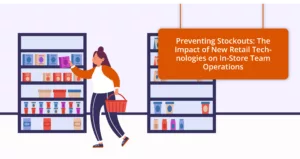DIY stores: Is the boom coming to an end? [1] It is true that while February 2022 recorded a 7% increase in activity compared to the same period in 2020 (pre-Covid), 2021 showed signs of slowing down. With a 5.33% decline in value and a 7.61% drop in volume, there is no need to worry (yet). However, it is advisable to consider the few clouds appearing on the horizon.
Over two years, the health crisis accelerated the transformation already underway in stores. They had to quickly implement major projects (repositioning, new concepts, the introduction of a myriad of services) to better serve their customers, while the surge in volumes significantly increased the workload for teams. It was a challenge, to say the least, but growth was achieved.
Today, the crisis is taking on a different and multifaceted nature for stores. On one hand, the decline in purchasing power caused by inflation raises concerns about consumers reallocating their budgets. So far, rising prices have offset declining volumes, but perhaps not for much longer. On the other hand, sourcing and recruitment challenges may eventually have a significant impact on in-store quality.
Now is the time to leverage the rapid transformations and capitalize on the acquired expertise. Now is the time to engage customers to choose “here rather than elsewhere” to preserve market share. And now is also the time to optimize working hours to maintain store profitability.
TimeSkipper offers a way to address these challenges, ensuring the smooth continuity of transformations and helping stores stay afloat despite the economic situation.
[1] https://www.lsa-conso.fr/bricolage-un-mois-de-fevrier-a-7-par-rapport-a-l-avant-covid,406731“
I – Allocating working hours effectively to serve the customer
After two years of “operational madness” and skyrocketing revenue growth, how is the organization faring? It’s easy to imagine that the surge in delivery services, Drive, and Click and Collect, driven by the e-commerce boom, followed by the strong return of in-store customers eager to tackle new projects, may have disrupted operations. Additionally, some activities or requirements (store maintenance, efficient goods reception, and replenishment) may have been deprioritized. Others, due to the need for flexibility and versatility, might have caused overburdening or underutilization of staff.
Adding to this is the worsening economic environment. Against an inflationary backdrop, declining sales volumes, combined with rising structural costs and overall expenses, are likely to partially erode store profitability.
It is therefore essential to have tools that measure and control costs to manage working hours, which are increasingly scarce and expensive. How?
Smart allocation of working hours in DIY stores
First and foremost, a reassessment of activities is necessary: it’s about understanding the weight of each activity per type of day in order to allocate working hours in a way that is useful, profitable, and fair to employees.
In this context, the right question to ask is: who should be assigned to which sector or activity, at what time, and for how long? This becomes simple if you have a time and task reference system (i.e., how long each task within each process takes). Indeed, such a system allows for the precise calculation of expected workloads and the number of people needed to handle them.
By sizing teams to the right service level for the customer and dedicating 100% of working hours to value creation, processes are streamlined, and losses are contained. It is also crucial to manage this equation on a day-to-day basis.
DIY Stores : How to reorganize teams in a shifting sector?
Download this white paper for free and implement a new team organization strategy to tackle the sector’s challenges.
Understanding the challenges of a rapidly changing sector
Optimizing team organization for greater profitability
Tackling the challenges of versatility and hyperspecialization
Supporting transformation with an innovative technological solution
II – Better recruiting, training, and retaining employees
It’s clear that teams have also had to adapt quickly to changes in operations: preparing online orders, managing Drive collection counters, new customer reception conditions, enhanced DIY advice, new requirements… A lot has been asked of them, but each employee has learned and grown!
Now, it’s time to identify and highlight skills, as well as capitalize on the expertise acquired, in alignment with operational needs. Let’s not forget that providing a tailored and differentiating customer experience remains, and increasingly so, a key factor in standing out. However, this is no small feat, as recruitment and retention challenges remain ongoing and represent a real obstacle to the sustainability of the organization.
Attracting, securing, and engaging employees in DIY stores
Does the store need more sales advisors, expertise in a specific area, a larger number of order preparers, or technicians in workshops (cutting or self-service workbench)? By calculating the store’s workload by activity, the answer should become quite clear at this point in the analysis.
Now, it’s time to determine who can do what within the teams. In this regard, a skills reference framework (sought-after or already identified) proves to be very useful for several reasons:
- Targeting recruitment towards talents committed to meeting the company’s specific needs,
- Directing and personalizing training programs based on employee needs (insufficient qualifications, growth in a key area for the store, continuous learning as part of a process change or new activities),
- Creating schedules that are aligned with store requirements, while also considering employee availability, preferences for flexibility, and skills. This ensures they are assigned to the right sales channel at the right time—to satisfy customers and themselves!
- Leveraging expertise to optimize operational execution.
By comparing employee schedules to the calculated workload, certain available hours can be identified for some individuals. These hours provide leeway that can be utilized based on individual skills and operational needs:
- Organizing in-store events on best practices, like securing a pergola.
- Using employees’ expertise to coach colleagues on specific topics or train external partners.
- Managing local chat or consumer service phone calls to guide customers in purchasing tools or seasonal products.
- Hosting personalized coaching sessions via videoconference (e.g., painting, laying parquet) or running online multi-participant workshops (e.g., how to install a ceiling-mounted light fixture).
This list is, of course, not exhaustive but reinforces the idea that diverse identified skills can evolve roles and differentiate the store’s customer experience. Whether allocated to traditional store management, employees, or new services, these levers provide employees with a broader variety of tasks and responsibilities.
The recognition and new skills they gain engage them and, consequently, help reduce turnover.
III – Countering logistical challenges in receiving and supply management
Logistics can lead to significant time losses in stores. DIY stores often suffer from a lack of visibility over their supply chain, complicating the optimization of product flows—which are already quite complex to manage—within the store.
Main logistical issues faced by DIY stores:
Raw material and finished product shortages—particularly for those manufactured in Asia—result in frequent stockouts at warehouses and suppliers.
In summary: stores are never certain they’ll receive the products they’ve ordered!The shortage of transporters has reached unprecedented levels, causing the entire system to seize up and become disorganized. In France alone, over 40,000 drivers are missing. Even a single absence can lead to massive delays. For some stores, delivery times can no longer be scheduled: with periods of low and high activity alternating unpredictably, restocking work is completely disrupted.
Product flow management within the store presents several challenges:
- The number of references is often high: nearly 70% are managed on stock with small volumes, while the rest experiences higher turnover rates with sometimes significant seasonal variations.
- Packaging and delivery supports vary, and some items can be bulky and heavy, making them difficult to handle.
- Finally, some products require custom preparation, necessitating both ad hoc stock management and dedicated preparation space to be as efficient as possible.
These issues lead to organizational difficulties, requiring enough personnel to receive products, optimize storage, and ensure high-quality customer service and sales advice.
The challenge lies in mastering upstream logistics to better manage product flows and optimize team activities in the store. Several levers should be considered:
- Raise the level of rigor for scheduled delivery slots to better manage teams, reducing the impact of fluctuating activity levels.
- Optimize product flow management within the store and communicate defined priorities to team leaders. For instance, knowing the precise stock levels of high-turnover products can help manage replenishment and reception, ultimately avoiding stockouts. Similarly, prioritizing pallet processing in storage areas over new deliveries could be more efficient.
- Manage resources and introduce flexibility to address challenges in anticipating activity variations. This involves correctly sizing teams, managing daily workloads for employees, and distributing tasks equitably based on store priorities.
Whether external or internal to the store, challenges such as hour allocation, employee retention, or product flow management can be addressed with better activity management. TimeSkipper’s solution enables stores to size their teams appropriately and optimize their working hours in near real-time based on needs and priorities while considering employee availability and preferences.
You can also count on TimeSkipper’s ten years of expertise to assist in creating your time reference system or implementing priority management and flow control. Within three to six months—the maximum time for return on investment—your store will be equipped to maintain its competitiveness and profitability amidst emerging market trends.






